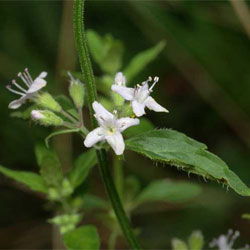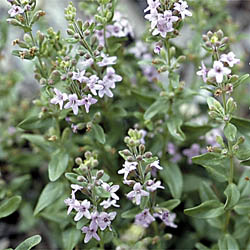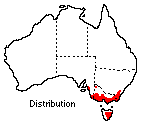Mentha diemenica
 |
 |
Wild Mint, Slender Mint
About twenty-five species of Mentha are distributed throughout the world, six being endemic to Australia. Seven exotic species have naturalised. All have aromatic foliage, a characteristic of the Lamiaceae family, to which they belong.
 Mentha
diemenica occurs in grassland and forest habitats from the Mt Lofty Ranges
in South Australia, throughout Victoria and Tasmania, and north to the Blue
Mountains of New South Wales. It is a strongly suckering plant which in cold,
dry conditions may become dormant, but when growing vigorously forms a dense
ground cover 10-15 cm high.
Mentha
diemenica occurs in grassland and forest habitats from the Mt Lofty Ranges
in South Australia, throughout Victoria and Tasmania, and north to the Blue
Mountains of New South Wales. It is a strongly suckering plant which in cold,
dry conditions may become dormant, but when growing vigorously forms a dense
ground cover 10-15 cm high.
The dull green, opposite leaves are ovate to lanceolate and 4-12 cm long. They are usually entire, but occasionally obscure teeth are noticed on the leaf margins. Leaves may be sessile or have a short petiole.
Flowers are borne in the upper leaf axils from late spring to summer. Each axil bears one to four flowers, giving two to eight flowers at each node. They are usually mauve or lilac with four small petals each extending 2-3 mm beyond the tubular calyx.
In cultivation, M. diemenica grows well in a slightly damp site in either reasonably heavy shade or full sun. In good conditions in a rockery it may become invasive and thus should be contained in a rock pocket or regularly controlled by removing suckers. It is a desirable plant between drive strips or near stepping stones where its fragrant aroma is noticed when it is trodden on.
Propagation is easy from cuttings taken at any time when the plant is growing vigorously, or by division when rooted pieces may be removed and re-established in a new situation. These new plants must be kept moist after transplanting.
Mentha diemenica is frost hardy, but it is susceptible to a rust fungus causing small brown spots on the underside of the leaves. This may be controlled with a suitable fungicide.
The leaves of this native mint may be used as a flavouring and garnish for cool summer drinks in a similar manner to the common introduced mint.
Text by John Wrigley, ANBG (1981)
Name meaning: Mentha diemenicaMentha - from a Latin name for mint; diemenica - of Tasmania (known earlier as Van Diemen's Land), where the species occurs. |
![An Australian Government Initiative [logo]](/images/austgovt_brown_90px.gif)

